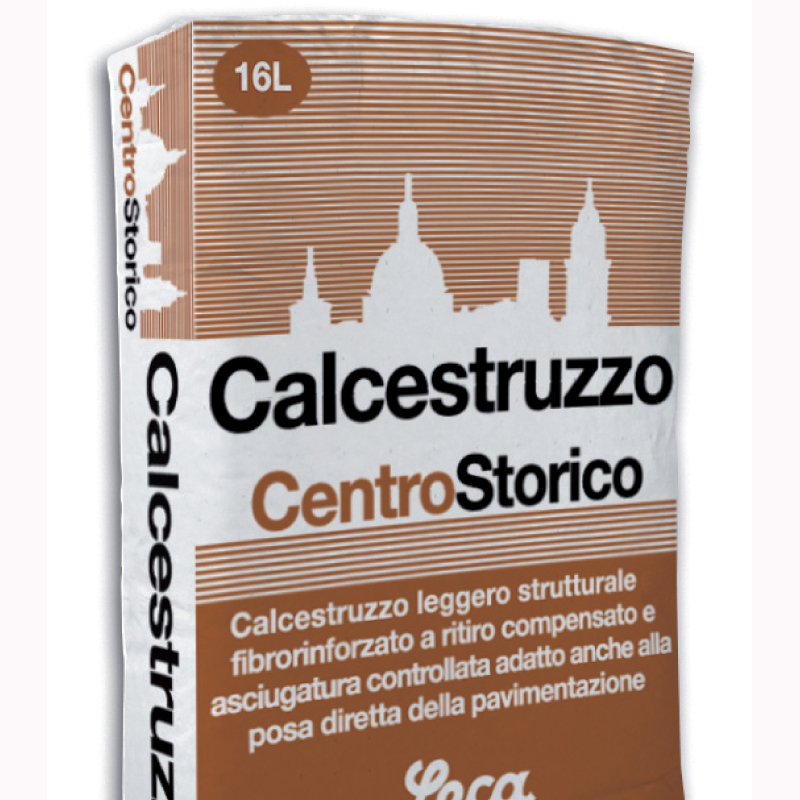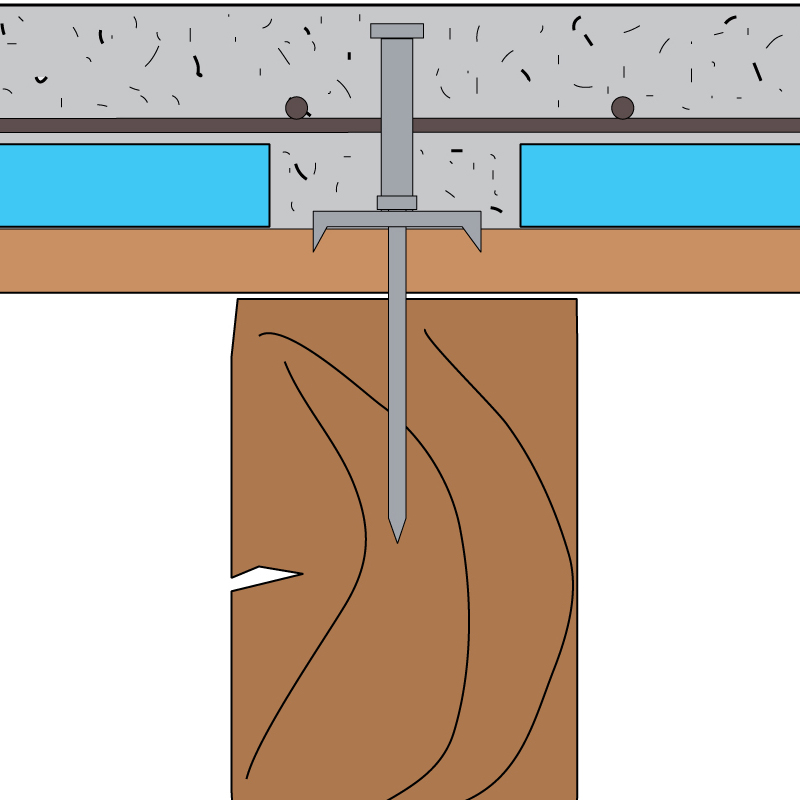Wood floors: the two types
Tecnaria connectors can be used for both new floors, flat or inclined planes, and for the consolidation of existing floors.
We can distinguish between the two most frequent types of floors: single joisted and double joisted floor.
SINGLE JOISTED WOOD FLOOR
THE COMPONENTS
The single joisted wood floor is the most common. The construction method is simple.
WOOD BEAMS
When restoration projects are undertaken it is important to analyse the geometry and mechanical characteristics of the wood. Solid wood, glue-laminated timber can be used for new floors.
CONCRETE
Structural concretes of minimum class C25/30 are normally used to make the load-bearing slab, with thickness no less than 5 cm. The technical installations (tubes, wires, etc.) must not be inserted in the slab.
LIGHT STRUCTURAL CONCRETES
The use of this type of concrete reduces the load of the strengthened slab while maintaining high mechanical strengths. It is especially recommended for use in seismic areas.
FLOOR BOARDS
The formwork onto which the concrete is cast can be made of wood boards, terracotta tiles or hollow bricks, fiberglass panels.
ELECTROWELDED MESH
A suitably dimensioned electrowelded mesh is always placed in the middle of the slab (normally Ø 6 mesh 20×20 cm). It is not necessary to fix the mesh to the connectors.
CTL CONNECTOR
The connector consists of a headed stud inserted in a base plate with folded corners forming 4 crampons; the stud and the plate are fixed in place with two screws. Two types of connectors are normally used: CTL BASE: Ø8 mm diameter screws, normally placed in direct contact with the wood beam; CTL MAXI: Ø10 mm diameter screws, when placed above and passing through the boarding.
PROTECTIVE SHEET
TECNARIA ‘Centuria’ breathable waterproof sheet is impermeable to the passage of water yet permeable to vapour. It prevents mortar from dripping through joints, cracks and pores in the boarding, the timber from absorbing any water from the cast concrete and dust from depositing on the underlying floors in the long run.
Vapour condensation on its underside will be avoided even in the presence of high saturation of the areas below the floor structure thus preserving the wood boarding. The protective sheet must be laid in contact with the wood, before the connectors are fixed in position. A 6×6 cm grid is printed on the sheet which facilitates the marking of the spacing. Duel faced fixing tape and eyelets are also supplied for perfect sealing
POSITIONING OF CONNECTORS
The CTL BASE connector is normally fixed in direct contact with the wood beam, the CTL MAXI normally on top of the boarding. The number and type of connectors to be positioned is determined by calculation (on average about 6/10 elements per m²); they should be fixed closely spaced near the walls and more widely spaced in the centre of the beam. It is advisable to turn the base plate every other fixing so that the screws are not aligned.
SHORING
It is important to shore the floors with props while the concrete sets. Where it is not possible to have access underneath the floor structure, it will be necessary to hang the floor by means of stays.
CONNECTION TO THE WALLS
It is advisable to join the slab to the bearing masonry walls on all sides of the floor. This precaution will also bring benefits in terms of stiffness and seismic resistance of the floor. This can be achieved in various ways, depending on the type of wall.
INSULATION
The insertion of a panel of rigid insulating material increases the section of the composite wood-concrete floor and beams without increasing the dead weight. The greater depth improves the reinforcement giving the advantages obtained in terms of strength, stiffness, number of connectors required and thermal and acoustic insulation values.
FIBRE REINFORCED CONCRETES
They are used when the thickness of the new layer must be limited to 20 or 30 mm, and when a reduction of the load is required. MINI CEM connector exclusivily to be used.
DOUBLE JOISTED WOOD FLOOR
THE COMPONENTS
These form the bearing element of the entire floor, on which the secondary joists rest, with the function of distributing the load. Connectors must be fixed in direct contact with the main beam. A suitably reinforced connecting concrete beam must be created on top of the beam. “BASE” or “MAXI” connectors can be used, according to the different application solutions.
CTL CONNECTORS
The connector consists of a headed stud inserted in a base plate with folded corners forming 4 crampons; the stud and the plate are fixed in place with two screws.
Two types of connectors are normally used:
CTL BASE: with Ø8 mm screws, it is normally fixed in direct contact with the wood beam;
CTL MAXI: with screws Ø10 mm in diameter, it is normally fixed on top of the boarding.
OMEGA CONNECTORS
The OMEGA connector is used to connect joists of reduced section in double-joisted floors.
It is the easiest solution to use when flat tiles or hollow bricks in terracotta are placed on top of the joists. The connector screw can be fixed between adjacent tiles, since it is very small. The BASE or MAXI connector should be used on the main beams.
OMEGA: Ø10 mm diameter screws.
HIGH CONNECTORS ON MAIN BEAMS
Connector with long stem fixed on the main beam, embedded in the whole slab. The connector head must be higher than the electrowelded mesh.
LOW CONNECTORS ON MAIN BEAMS
Connector with reinforcement for connection to the top section of the slab: a reinforcement cage is created.
FLUSH BEAMS
Low stem connector and secondary beams at the same level of the main beam. In these cases it is always preferably to place the connector in direct contact with the beam, by removing a portion of the boarding.
THROUGH SCREWS
Screws passing through the secondary joists into the primary beam do not create an efficient connection. This kind of connection is not feasible, as the screw is not able to transmit the shear stresses. This solution offers no benefit.
CASTING CONTAINMENT
Formwork, usually made of wood, must be provided between one joist and another, to contain the poured concrete. The operation can be quite laborious in the presence of irregular geometries. The joints must be sealed with polyurethane foam.
FLOOR BOARDS
The secondary joists are normally covered by wood boarding or a layer of hollow bricks, like in single joisted floors.
INTERRUPTED JOISTS
The formation of a continuous concrete beam on top of the timber one makes the strengthening uniform and efficient.
CONTINUOUS JOISTS
The secondary joists are normally covered by wood boarding or a layer of hollow bricks, like in single joisted floors.
SECONDARY BEAMS (JOISTS)
Joists can be continuous, that is pass over the main beam, or interrupted on meeting the main beam. The latter situation is the more favourable. The calculation for the spacing of the connectors on the secondary beams will be carried out in the same way as for a single-joisted floor.
When the floor decking is made up of closely laid flat tiles or hollow bricks in terracotta the appropriate “OMEGA” connectors can be installed. They are minimally invasive and can be used with continuous tiles and are suitable for joists with a reduced section (minimum base 6 cm, minimum height 8 cm).






















